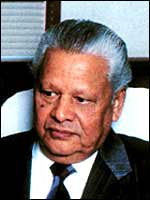 |
 |
| BPL Communications' R. Chandrasekhar
(left) and BPL patriarch T.P.G. Nambiar: Murky family
soap turns more dramatic |
The bad blood
between BPL group patriarch T.P.G. Nambiar and his son-in-law,
Rajeev Chandrasekhar, is intensifying. On May 10, 2005, the Company
Law Board (CLB) rejected Nambiar's petition seeking a stay on
the sale or transfer of a 57 per cent stake in BPL Communications
owned by his son-in-law. The Chandrasekhar-controlled BPL Communications
is the holding company for BPL Cellular Ltd (which holds licences
for the Tamil Nadu, Maharashtra, Goa, Kerala and Pondicherry circles)
and BPL Mobile Communications (which holds a licence for the Mumbai
circle). There have been reports that Chandrasekhar is planning
to sell a portion of BPL Communications to either Vodafone or
Essar. The exact shareholding pattern in BPL Communications is
unclear, with both sides claiming a controlling stake.
Nambiar needs money. The BPL Group is bleeding
and is saddled with high-cost debts of about Rs 1,200 crore. A
comprehensive debt restructuring (CDR) package, which has been
in the works for the last three years, has been held up because
Nambiar and his son Ajit have been unable to bring in Rs 120 crore
for a one-time settlement, which will result in a portion of the
debt being written off.
This is where BPL Communications, which has 2.6 million subscribers,
comes in. In January 2005, Morgan Stanley estimated its enterprise
value at $1.3 billion (Rs 5,720 crore). If the Nambiars can get
a slice of this cake, their funds crunch will be resolved. "The
mobile business was funded by BPL. It was our brand equity that
helped it grow. We will pursue all avenues to protect our interests,"
say sources close to Nambiar.
The Chandrasekhar camp will have none of
this. "On two occasions in the past, they (the Nambiars)
decided not to participate in (BPL Communications) rights issues.
Now that it has started making good money, they want a piece of
the action," sources close to Chandrasekhar point out. But
is he really selling out? The man himself avoids a direct answer.
"We are talking to various players for a strategic investment
partner," he says.
The next act in this family soap will unfold
on July 11, when the CLB takes up Nambiar's arguments. Keep watching
this space.
-Venkatesha Babu
GLITTER
Choice Of Sparklers
 |
| DTC's Penny: Rolling out the stones |
Diamonds
are forever, are a girl's best friend, and all that, but diamonds
aren't soap. Why then has the Diamond Trading Company (DTC), the
marketing arm of the De Beers Group, introduced so many brands
of diamond jewellery in the Indian market? First there was Nakshatra,
then came Asmi, followed by Arisia and, more recently, Sangini.
After all, when buying a diamond you would assume that consumers
are most concerned with its intrinsic value, unlike when, say,
picking up a Dove soap.
Gareth Penny, Managing Director of the London-based
DTC, explains: "It's a way of creating excitement. We should
be able to sell emotions like love and commitment, rather than
just a commodity. We offer marketed products, and focus on design,
beauty and elegance." He reveals that DTC spends $8-10 million
(Rs 35.2-44 crore) annually on marketing in India.
It's easy to see why: India is the third-largest
market after the US and Japan, and is growing at 20 per cent annually,
even as global demand chugs along at 7-8 per cent. Small wonder
then that Penny can't get the "India Shining" slogan
out of his system!
-Brian Carvalho
POLICY WATCH
No Full Stops Anymore
The government is determined to push financial
sector reforms through.
On
May 21 this year, finance minister P. Chidambaram sprang a surprise.
He announced that the government would go through with, and complete,
banking and financial sector reforms by September-end. Speaking
at the national meet of the Confederation of Indian Industry on
May 17, the 59-year-old lawyer-turned-politician said: "The
first thing we have to do is complete the agenda of financial
sector reforms and end all the uncertainties in this sector."
The Monsoon Session of Parliament (beginning
in July) is packed with economic Bills (see Bills In The Pipeline)
that are likely to change the face of the Indian financial sector.
Doing away with the 10 per cent cap on voting rights for private
sector banks through an amendment of the Banking Regulation (Amendment)
Bill, 2005, for instance, will encourage foreign banks to raise
their stakes in private sector Indian banks and bring in much-needed
foreign capital. Similarly, The Reserve Bank of India (Amendment)
Bill, 2005 gives the Reserve Bank of India the flexibility to
set a new cash reserve ratio (CRR) and statutory liquidity ratio
(SLR) for stronger banks. This will release massive amounts of
productive funds into the market.
| BILLS IN THE PIPELINE |
| NAME OF THE BILL |
IMPACT |
| The Reserve Bank of India (Amendment) Bill,
2005 |
Provides more operational flexibility to the
central bank to fix SLR and CRR for different banks so as
to make available more funds for productive growth |
| The Banking Regulation (Amendment) Bill,
2004 |
Removes the 10 per cent cap on voting rights.
Will encourage foreign banks to set up subsidiaries and attract
foreign investments |
| Special Economic Zone Bill, 2005 |
Makes units within SEZs eligible for 100 per
cent tax exemption for the first five years and 50 per cent
for the next five. |
| The Pension Fund Regulatory and Development
Authority Bill, 2005 |
Introduces a new regulatory mechanism for a
"defined contribution" pension scheme introduced from January
1, 2004 |
| Credit Information Companies (Regulation)
Bill, 2004 |
Help banks to deal with NPAs by providing information
regarding creditworthiness of various categories of customers |
| The Factories (Amendment) Bill, 2004 |
Provides flexibility in the matter of employing
women workers on night shifts in factories |
| The Securities Laws (Amendment) Bill 2004 |
Demutualises stock exchanges and enhances penal
provisions to protect investors' interests |
| Insurance Regulatory Authority Bill, 2004 |
Increases the FDI cap from 26 per cent to 49
per cent in private insurance companies |
Again, amending the Insurance Regulatory and
Development Act, (1998) to increase the foreign direct investment
(FDI) limit in insurance companies from 26 per cent to 49 per
cent, and passing the Pension Fund and Regulatory and Development
Authority Bill, 2005, will unshackle these sectors.
The passage of these Bills (the Left parties
and the BJP willing) will enable India to attract more FDI (the
country received $4 billion, or Rs 17,600 crore, in 2003-04) and,
hopefully, close the gap with China, which attracted $60.63 billion
(Rs 2,66,772 crore) in foreign investments in 2004.
Empirical data shows that foreign investments
in sectors such as information technology, business process outsourcing
and car making, among others, have made Indian companies more
productive and turned some of them into formidable global competitors.
Consumers have benefited from lower prices, higher quality and
greater choice. And domestic demand has soared as thousands of
new jobs were created.
The Finance Minister is hoping that these
stories will be replicated in the financial sector, and, because
of its linkages across the economy, in other sectors as well.
China, here we come!
-Ashish Gupta
PHARMA
A New Synergy
 |
| Exports ho! Divi's unit near Hyderabad |
What are pharma
companies doing setting up export-oriented units (EOUs)? Murli
K. Divi, Chairman and Managing Director of Hyderabad-based Divi's
Laboratories, has just inked a deal with a us-based pharma major
for the supply of a specialty ingredient and is setting up a dedicated
EOU for this customer alone. The investment: Rs 30 crore; the
location: Vishakapatnam. Divi's is not alone. The Ahmedabad-based
Dishman Pharmaceuticals & Chemicals has two such facilities
in Bavla, near Ahmedabad, that manufacture Eprosartan, an active
pharmaceutical ingredient used in the manufacture of an anti-hypertension
drug, under contract for Solvay Pharmaceutical B.V. of the Netherlands.
"We hope to add two more such EOUs in the next month,"
says Vikram Oza, Vice President (Finance), Dishman. Adds Divi:
"We are working with close to a dozen global pharma MNCs
and hope to replicate this model in other cases." But why
an EOU? "These units don't pay any income tax, sales tax
or excise duties till 2010," says Oza. That's why other pharma
companies, like Matrix Laboratories, which do not have dedicated
customer-specific contract manufacturing units, have also opted
to set up EOUs.
-E. Kumar Sharma
|








